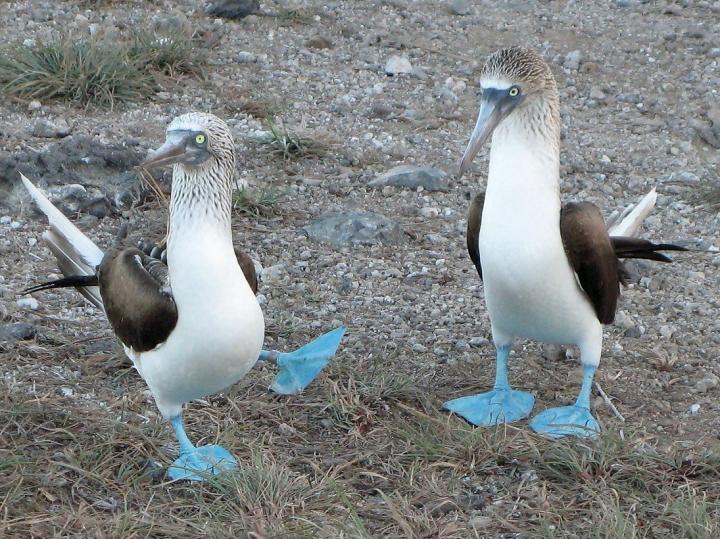Birds show surprising resilience in the face of natural stresses

Blue-footed Boobies can bounce back from stresses experienced early in life. Credit: H. Drummond
Some experiments with birds in captivity have found that increasing early-life stress through food deprivation, elevated stress hormones, and other means has negative effects once birds reach adulthood, causing them to live shorter lives and produce fewer offspring.
However, Drummond and Ancona argue that the artificial stresses created in these experiments go well beyond what would ever be experienced by wild birds and therefore don't reflect what happens in nature.
Reviewing the available studies describing how wild birds fare as adults after experiencing stress in the nest, they give several examples of birds' ability to compensate for their early disadvantages, making adjustments such as beginning to breed earlier in life.
Drummond's interest in bird resilience arose from his research on Blue-footed Boobies. “There were dozens of published studies, mostly experimental, appearing to show that setbacks early in infancy left birds scarred in some way for the rest of their lives,” he explained.
“But when we analyzed our own observations on Blue-footed Boobies, following individuals banded at fledging over their lifetimes, what stood out was their resilience to severe stresses in infancy. For example, boobies that grew up suffering daily oppression by their elder siblings performed just as well as those siblings on a whole suite of measures taken during adulthood, including annual survival at all ages, age of first breeding, aggressive defense of offspring, and reproductive success at all ages.”
“The authors have helped reorient researchers to a vastly understudied area–the evolutionary interplay between early life conditions and phenotypic plasticity,” adds Daniel Ardia, an expert in life history tradeoffs in birds from Franklin & Marshall College who was not involved with the paper. “While laboratory experiments are essential to understand genetic and physiological mechanisms, it is only in field conditions that we will gain insight into the flexibility of development in the face of changing environmental conditions. This Perspective helps chart the way forward for field and laboratory researchers alike.”
###
About the journal: The Auk: Ornithological Advances is a peer-reviewed, international journal of ornithology. The journal has been the official publication of the American Ornithologists' Union since 1884. In 2009, The Auk was honored as one of the 100 most influential journals of biology and medicine over the past 100 years, and currently holds the top impact factor among ornithological journals.
“Observational field studies reveal wild birds responding to early-life stresses with resilience, plasticity, and intergenerational effects” is available at http://www.
Media Contact
All latest news from the category: Life Sciences and Chemistry
Articles and reports from the Life Sciences and chemistry area deal with applied and basic research into modern biology, chemistry and human medicine.
Valuable information can be found on a range of life sciences fields including bacteriology, biochemistry, bionics, bioinformatics, biophysics, biotechnology, genetics, geobotany, human biology, marine biology, microbiology, molecular biology, cellular biology, zoology, bioinorganic chemistry, microchemistry and environmental chemistry.
Newest articles

Sea slugs inspire highly stretchable biomedical sensor
USC Viterbi School of Engineering researcher Hangbo Zhao presents findings on highly stretchable and customizable microneedles for application in fields including neuroscience, tissue engineering, and wearable bioelectronics. The revolution in…

Twisting and binding matter waves with photons in a cavity
Precisely measuring the energy states of individual atoms has been a historical challenge for physicists due to atomic recoil. When an atom interacts with a photon, the atom “recoils” in…

Nanotubes, nanoparticles, and antibodies detect tiny amounts of fentanyl
New sensor is six orders of magnitude more sensitive than the next best thing. A research team at Pitt led by Alexander Star, a chemistry professor in the Kenneth P. Dietrich…





















